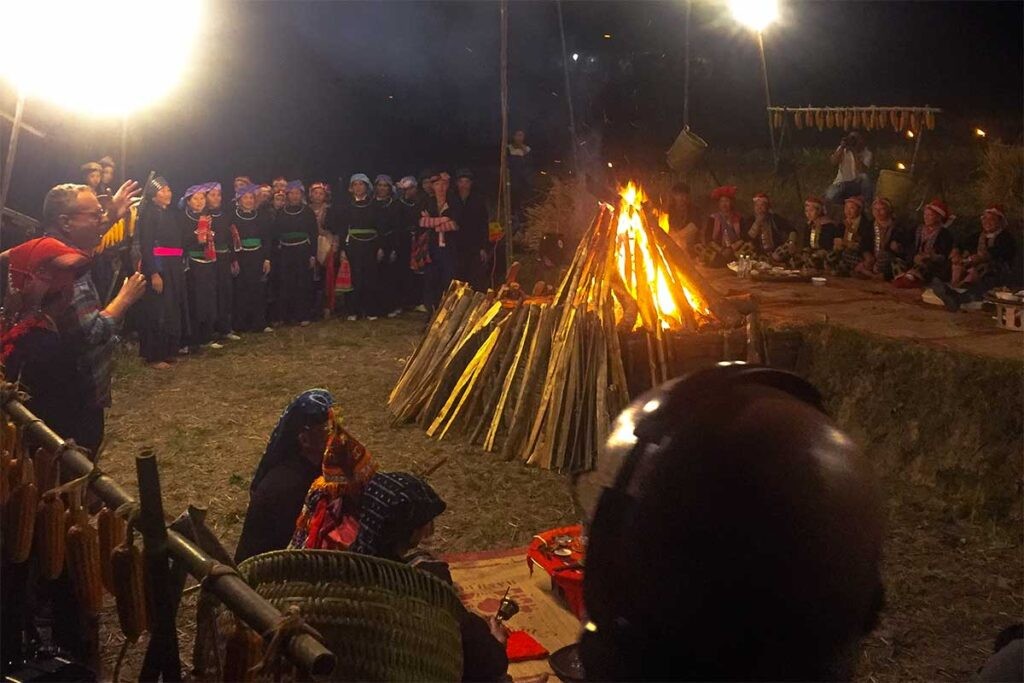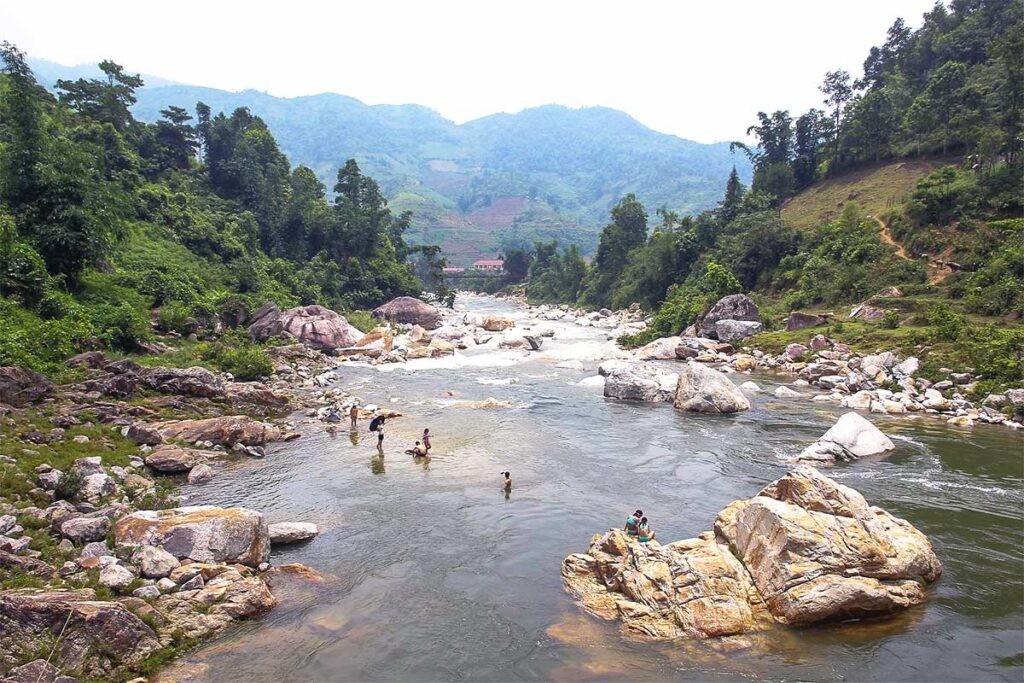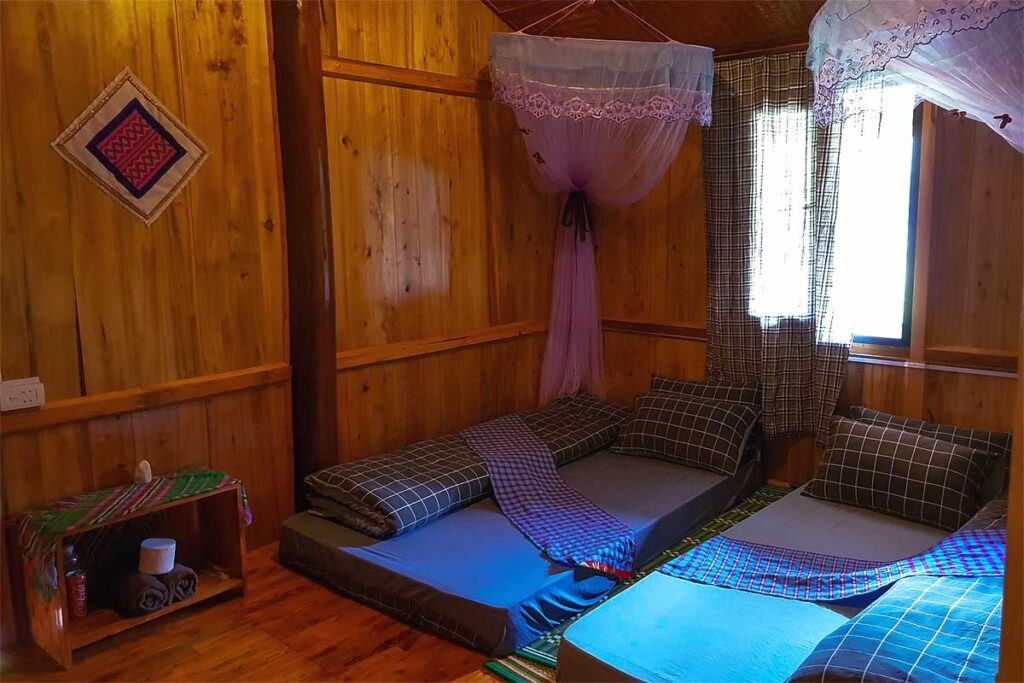Ban Ho Village is primarily known for its stunning natural landscapes, authentic cultural experiences, and trekking opportunities, and SIXT.VN is here to help you explore it all. Home to the Tay ethnic group, this village offers a unique glimpse into traditional Vietnamese life, making it a must-visit destination for travelers seeking adventure and cultural immersion. With SIXT.VN, planning your trip to Ban Ho Village becomes seamless, ensuring a memorable and enriching experience.
1. Discovering Ban Ho Village
1.1. Where Exactly is Ban Ho Village Located?
Ban Ho Village is nestled in the breathtaking Muong Hoa Valley in northwest Vietnam, approximately 25 kilometers from Sapa. This strategic location allows for easy access, making it ideal for both day trips and extended stays.
1.2. Who Calls Ban Ho Village Home? Which Ethnic Group Resides There?
The Tay ethnic group primarily inhabits Ban Ho Village. Known for their distinctive stilt houses and advanced rice farming techniques, the Tay community also excels in cultivating cotton, mulberries, and silkworms. Tay women are particularly famous for their intricate brocade weaving, creating stunning costumes and home decorations that showcase their rich cultural heritage. According to a 2019 study by the Vietnam National Museum of Ethnology, the Tay people have preserved their traditional customs and crafts for centuries, contributing significantly to the cultural diversity of the region.
 Tay Women Weaving Brocade
Tay Women Weaving Brocade
1.3. What is the Layout and History of Ban Ho Village?
Ban Ho Village features a traditional Tay settlement characterized by stilt houses that blend beautifully with the natural environment. The village’s layout is typical of Tay communities, designed to optimize agricultural and social activities. While the exact age and size may not be meticulously documented, its cultural richness and traditional way of life are evident throughout.
2. Key Highlights of Ban Ho Village
2.1. How Can I Experience Ethnic Minority Life in Ban Ho Village?
Walking through Ban Ho Village offers an intimate glimpse into the daily lives of the Tay people. Observe villagers working in the fields, weaving brocade, and performing their traditional routines. To overcome language barriers and gain deeper insights into their customs, consider hiring a local guide. According to a 2021 report by the Sapa Tourism Office, guided tours significantly enhance visitors’ understanding and appreciation of local culture.
2.2. What is the Homestay Experience Like in Ban Ho Village?
Staying in a homestay with a Tay family provides a unique and enriching experience. While accommodations may be basic, the warmth and hospitality of the hosts make it memorable. Sharing family dinners, trying local dishes, and participating in daily activities offer a genuine connection to the local culture. The Ministry of Culture, Sports and Tourism reports that homestays are increasingly popular among tourists seeking authentic cultural experiences.
 Homestay Dinner in Ban Ho Village
Homestay Dinner in Ban Ho Village
2.3. Is Ban Ho Village a Good Trekking Destination?
Yes, Ban Ho Village is an excellent trekking destination for both day tours and multi-day adventures. The trails lead through terraced rice fields, bamboo forests, and picturesque landscapes, offering breathtaking views and an immersive nature experience. A 2020 study by the Vietnam Institute of Tourism Research highlights that trekking is one of the most popular activities for visitors in the Sapa region, offering both physical activity and stunning scenery.
2.4. What Water Activities Can I Enjoy in Ban Ho Village?
Ban Ho Village is where the Muong Hoa Stream meets the La Ve Stream. After a hike, cooling down in the local stream is a refreshing experience. The warmer temperatures in Ban Ho, due to its lower elevation compared to Sapa, make swimming especially enjoyable. Be sure to check local water conditions before swimming.
 Swimming in Muong Hoa Stream
Swimming in Muong Hoa Stream
2.5. Where Can I Enjoy a Herbal Bath Near Ban Ho Village?
Nearby Ban Ho is the Red Dao village of Nam Toong, renowned for its herbal baths. These baths involve soaking in tubs filled with medicinal herbs, known for their relaxing and health benefits. Enjoying a herbal bath here provides a soothing end to a day of exploration, typically costing around $5-$10. According to a 2022 article in the Journal of Traditional Vietnamese Medicine, Red Dao herbal baths have been used for centuries to promote health and relaxation.
2.6. What Local Cuisine Should I Try in Ban Ho Village?
The cuisine of Ban Ho is a highlight, featuring fresh and delicious dishes such as grilled stream fish, pickled bamboo shoots, sticky rice cooked in bamboo, and grilled chicken and pork. These dishes can be enjoyed during a family dinner in a homestay, offering a taste of local culinary traditions.
3. How to Reach Ban Ho Village
3.1. What is the Easiest Way to Get to Ban Ho Village from Hanoi?
Ban Ho Village is located in the Muong Hoa Valley, one of the furthest villages from Sapa town. Although it is remote, it is relatively easy to reach, being close to the main Muong Hoa Road and visible on Google Maps. First, travel to Sapa, as there are no direct transportation options from Hanoi to Muong Hoa Valley. SIXT.VN can help you arrange transportation from Hanoi to Sapa, ensuring a smooth and comfortable journey.
3.2. What Transportation Options Are Available From Hanoi to Sapa?
- Limousine Bus: A comfortable daytime option.
- Sleeper Bus: Available at night but not recommended for comfort.
- Train: Travel from Hanoi to Lao Cai station, then take a direct taxi to Ban Ho or travel to Sapa first.
SIXT.VN offers reliable booking services for all these options, tailored to your preferences and budget.
3.3. How Can I Travel From Sapa to Ban Ho Village?
- Trekking: Some trekking tours include Ban Ho Village, especially multi-day treks exploring less-visited parts of Muong Hoa Valley.
- Taxi: Taxis are readily available in Sapa town (not Grab). While some homestays in Ban Ho cannot be reached directly by car, a taxi can get you close enough, with motorbike taxis available to take you directly to the door. The drive from Sapa is approximately 25 km and costs about 300,000 VND.
- Renting a Motorbike or Scooter: Renting a motorbike in Sapa is a more affordable option. Navigation is straightforward, mostly along a single road. However, driving in the mountains without experience or a valid motorbike license is not recommended.
SIXT.VN provides detailed information and assistance in arranging these transportation options, ensuring a safe and enjoyable trip.
4. Choosing a Homestay in Ban Ho Village
4.1. What Should I Expect From a Homestay in Ban Ho Village?
Homestays in Ban Ho range from basic to more comfortable options. While luxury is not the norm, some offer modern amenities like Wi-Fi and private rooms. Basic homestays might have shared dorm-style rooms with simple mattresses, providing a more authentic cultural immersion. All homestays in Ban Ho are required to have Western-style toilets, showers, and mosquito nets.
SIXT.VN offers a curated selection of homestays, ensuring quality and comfort during your stay.
 Basic Room in Ban Ho Homestay
Basic Room in Ban Ho Homestay
4.2. What is the Family Dinner Experience Like in a Ban Ho Homestay?
A highlight of staying in a Ban Ho homestay is the family dinner experience. Witness the preparation of traditional dishes over an open fire and share a meal with the family. This offers a unique opportunity to learn about local cuisine and connect with the warm hospitality of the Tay people. You might even be offered a taste of homemade rice wine, which you can politely decline if you prefer.
5. Essential Tips for Visiting Ban Ho Village
5.1. What Kind of Gifts Should I Bring for Children in Ban Ho Village?
Avoid giving candy or money. Instead, offer books or pencils, which are more useful and appreciated. According to a 2018 UNICEF report, educational materials contribute more positively to children’s development than sweets or cash.
5.2. How Should I Approach Photography in Ban Ho Village?
Always ask for permission before taking photos of people to show respect for their privacy and culture.
5.3. What is the Best Way to Respect the Rice Fields in Ban Ho Village?
Avoid standing in the rice fields, as they are the livelihood of the locals. Damaging the crops can have a significant impact on their income.
5.4. When is the Best Time to Visit Ban Ho Village?
Visit in March, April, May, September, October, and November for the best weather. To see the rice fields, visit between July and early September, although this is the rainy season. According to historical weather data, these months offer the most pleasant conditions for trekking and outdoor activities.
5.5. How Should I Handle Local Sellers in Ban Ho Village?
Some locals may follow you to chat and try to sell products. A friendly “No” will eventually discourage them if you’re not interested.
5.6. What Other Villages Should I Visit Near Ban Ho Village?
Consider visiting Lao Chai, Ta Van, Giang Ta Chai, and Nam Cang for a more comprehensive experience of the region.
6. Enhancing Your Trip with SIXT.VN
6.1. How Can SIXT.VN Assist with My Travel Plans?
SIXT.VN offers a comprehensive range of services to make your trip to Ban Ho Village seamless and enjoyable. From airport transfers to hotel bookings and guided tours, SIXT.VN ensures every detail is taken care of.
6.2. What are the Benefits of Using SIXT.VN for Airport Transfers?
SIXT.VN provides safe and reliable airport transfer services, ensuring you reach your destination without any hassle. Our professional drivers and comfortable vehicles guarantee a smooth start to your adventure.
6.3. How Does SIXT.VN Simplify Hotel Bookings?
With SIXT.VN, you can choose from a wide range of accommodations to suit your budget and preferences. We offer detailed information and customer reviews to help you make the best choice.
6.4. Why Choose SIXT.VN for Guided Tours?
SIXT.VN offers expert-led guided tours that provide deeper insights into the local culture and attractions. Our knowledgeable guides ensure you don’t miss any hidden gems and have a truly enriching experience.
7. Unique Cultural Experiences in Ban Ho Village
7.1. Participating in Local Festivals
Ban Ho Village and the surrounding Sapa region host various festivals throughout the year, offering vibrant displays of local culture. The “Roong Pooc” festival of the Giay ethnic group, for instance, celebrates the end of the harvest season with traditional dances, games, and rituals. Participating in these festivals provides a unique opportunity to immerse yourself in the local traditions. According to the Sapa Tourism Department, these festivals attract thousands of visitors each year, contributing significantly to the local economy.
7.2. Learning Traditional Crafts
Engage in hands-on experiences by learning traditional crafts from local artisans. Participate in a brocade weaving workshop and discover the intricate techniques passed down through generations. Alternatively, learn the art of bamboo basket making, a skill essential to daily life in the village. These experiences offer a deeper appreciation for the skill and artistry of the local people. A 2023 study by the Vietnam Craft Association highlighted the growing interest in preserving and promoting traditional crafts as a means of sustainable tourism.
7.3. Exploring Ancient Rock Carvings
Venture beyond Ban Ho Village to explore the ancient rock carvings in the Muong Hoa Valley. These mysterious carvings, dating back thousands of years, depict various symbols and figures, offering a glimpse into the region’s ancient history. While their exact meaning remains a subject of debate, they are believed to have been created by the ancestors of the local ethnic groups. The carvings are a protected historical site, and guided tours are available to provide insights into their significance.
8. Sustainable Tourism in Ban Ho Village
8.1. Supporting Local Businesses
Choose locally owned businesses, such as homestays, restaurants, and shops, to ensure that your money directly benefits the community. By supporting these businesses, you contribute to the economic well-being of the local people and help preserve their traditional way of life. A 2022 report by the World Tourism Organization emphasizes the importance of supporting local businesses in promoting sustainable tourism.
8.2. Respecting the Environment
Practice responsible tourism by minimizing your environmental impact. Avoid littering, use reusable water bottles, and choose eco-friendly transportation options whenever possible. Respect the natural beauty of the region by staying on marked trails and avoiding disturbance of wildlife. A 2021 study by the Vietnam National Administration of Tourism highlights the growing awareness of environmental issues among tourists and the increasing demand for eco-friendly tourism options.
8.3. Conserving Water and Energy
Be mindful of your water and energy consumption during your stay in Ban Ho Village. Take shorter showers, turn off lights when leaving your room, and avoid wasting water. These small actions can make a significant difference in reducing your environmental footprint.
9. Addressing Common Travel Challenges
9.1. Overcoming Language Barriers
While English is not widely spoken in Ban Ho Village, SIXT.VN can provide translators or guides to help you communicate with the locals. Learning a few basic Vietnamese phrases can also enhance your interactions and show respect for the local culture.
9.2. Navigating Transportation
SIXT.VN can arrange transportation from Sapa to Ban Ho Village, ensuring a safe and comfortable journey. We can also provide information on local transportation options, such as taxis and motorbikes, and offer tips on navigating the region.
9.3. Finding Reliable Information
SIXT.VN provides up-to-date information on travel regulations, safety tips, and local customs, ensuring you are well-prepared for your trip. We also offer 24/7 customer support to address any concerns or questions you may have.
10. Frequently Asked Questions About Ban Ho Village
10.1. What is the Best Time of Year to Visit Ban Ho Village?
The best time to visit Ban Ho Village is during the dry season, from March to May and September to November, offering pleasant weather for trekking and outdoor activities.
10.2. Are There ATMs in Ban Ho Village?
No, there are no ATMs in Ban Ho Village. It’s advisable to withdraw cash in Sapa before heading to the village.
10.3. Is it Safe to Drink the Tap Water in Ban Ho Village?
No, it’s not recommended to drink tap water. Stick to bottled water or use a water purifier.
10.4. What Should I Pack for a Trip to Ban Ho Village?
Pack comfortable trekking shoes, lightweight clothing, rain gear (especially during the rainy season), insect repellent, sunscreen, and a hat.
10.5. Are There Any Health Precautions I Should Take?
Consult your doctor about necessary vaccinations and malaria precautions before traveling to Ban Ho Village.
10.6. Can I Use My Credit Card in Ban Ho Village?
Credit cards are not widely accepted in Ban Ho Village. Cash is the preferred method of payment.
10.7. What is the Currency Used in Ban Ho Village?
The currency used in Ban Ho Village is the Vietnamese Dong (VND).
10.8. How Far in Advance Should I Book My Homestay?
It’s advisable to book your homestay at least a few weeks in advance, especially during peak season, to ensure availability.
10.9. What is the Electricity Voltage in Ban Ho Village?
The electricity voltage in Ban Ho Village is 220V. Consider bringing a travel adapter if your devices use a different voltage.
10.10. Are There Any Cultural Etiquette Tips I Should Be Aware Of?
Dress modestly when visiting religious sites, remove your shoes before entering homes, and avoid pointing your feet at people.
Ready to embark on an unforgettable journey to Ban Ho Village? Let SIXT.VN take care of all your travel needs, ensuring a seamless and enriching experience. From convenient airport transfers to comfortable hotel bookings and expert-led guided tours, we’ve got you covered. Contact us today at +84 986 244 358 or visit our website at SIXT.VN to start planning your adventure now! Located at 260 Cau Giay, Hanoi, Vietnam, we are here to help you explore the beauty and culture of Ban Ho Village with ease and comfort. Book your tour now to explore Vietnam tourism, travel Vietnam and Vietnam travel.



